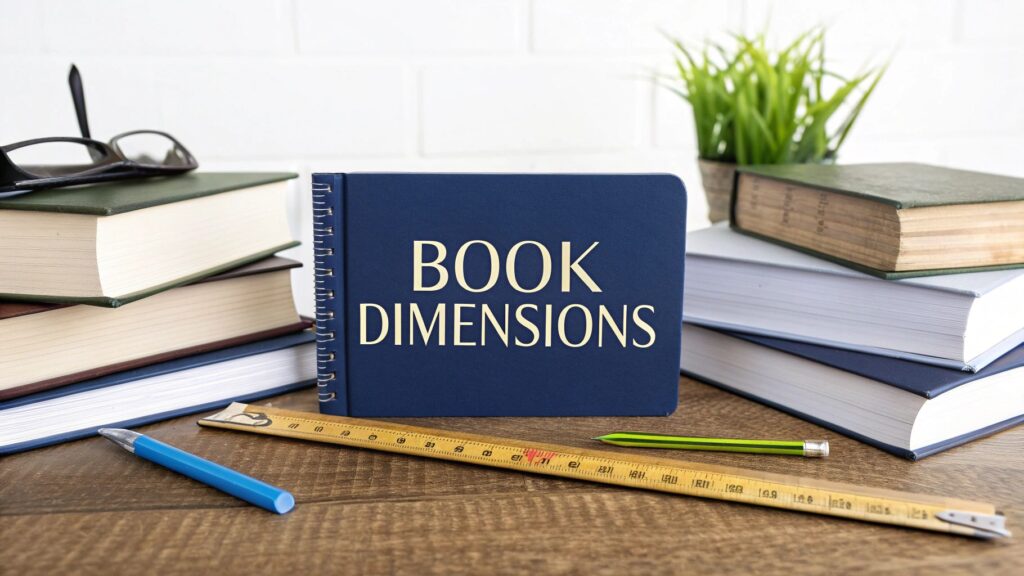While there’s no single, official rulebook for standard book sizes, the publishing world definitely has its unwritten laws. Over time, a set of common dimensions—what we call trim sizes—has emerged, and they vary quite a bit from genre to genre.
Picking the right trim size is one of the first, most foundational decisions you'll make. It’s not just about aesthetics; it’s a strategic choice that signals to readers what kind of book you’ve written and impacts everything from your printing costs to how it feels in their hands.
Why Your Book's Size Is a Crucial First Step
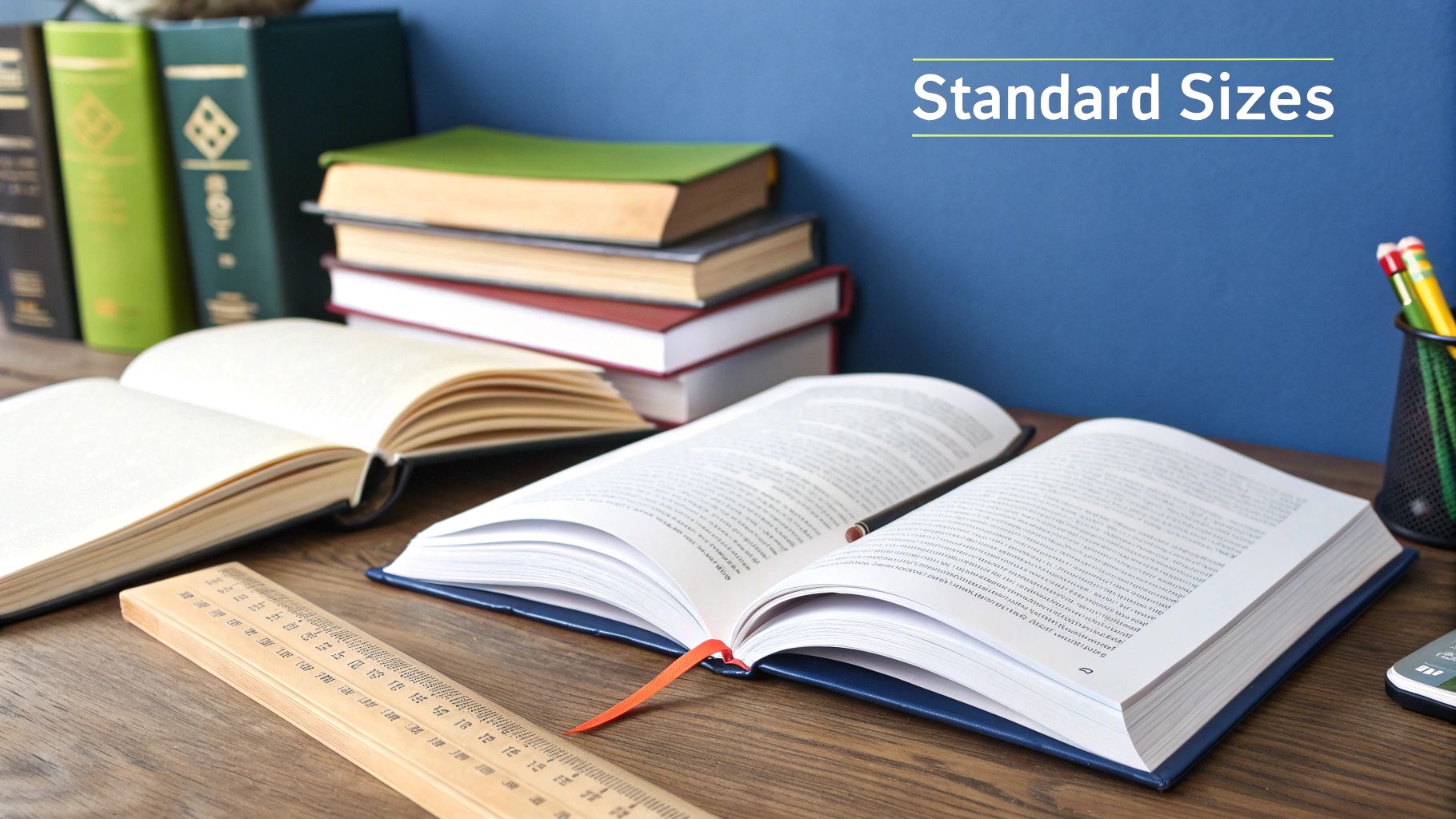
It’s easy to think of a book’s physical size as a finishing touch, something you figure out at the end. But in reality, it’s like an architect deciding on the footprint of a house before drawing up the floor plans. Getting it wrong can compromise everything else you build on top of it. This choice is a big deal, and it sets the stage for your book's entire journey.
A book’s dimensions instantly tell a story. A compact 5" x 8" paperback practically screams "grab-and-go novel," perfect for a commute. On the other hand, a big 8.5" x 11" book immediately feels like a workbook or a technical manual. If you stray too far from these established norms, you risk confusing potential buyers. Booksellers might even hesitate to carry your title if it doesn't fit neatly on their shelves alongside similar books.
The Ripple Effect of One Decision
Choosing a trim size isn't a decision that lives in a vacuum. It creates a ripple effect, touching nearly every other part of the publishing process. Your choice here directly shapes your book’s future and, just as importantly, your budget.
Think about how this one choice impacts everything else:
- Production Costs: Standard sizes are popular for a reason—they’re efficient. Printers have massive rolls of paper, and standard dimensions are calculated to get the most pages out of a single sheet with minimal waste. Go custom, and you’re paying for all that trimmed-off paper.
- Reader Experience: How a book feels is a huge part of the experience. A dense thriller with a high page count feels perfectly manageable in a trade paperback format. But cram that same story into a tiny, pocket-sized book, and it suddenly becomes a dense, intimidating brick.
- Interior Layout: Your trim size is the canvas. It dictates everything your interior designer has to work with—the margins, the font size, how many words fit on a line. All these tiny details add up to create a professional look and a comfortable reading experience.
- Distribution and Shelving: Bookstores and libraries are built on standards. Their shelves are designed for specific dimensions. An oddly-sized book is a logistical headache that can end up shoved in an awkward spot, hidden from the very readers you’re trying to reach.
Working within industry standards isn’t about stifling your creativity. It’s about using a powerful tool to your advantage. It ensures your book looks the part and fits seamlessly into the ecosystem of printing, distribution, and bookselling.
At the end of the day, picking a standard book size is an informed, strategic move. It sets your project up for a smoother journey to publication and helps it connect with the right audience the moment they see it.
Understanding Trim Size and Why It Matters
Before we get into the nitty-gritty of dimensions, let's talk about a term you'll hear thrown around constantly: trim size. It sounds technical, but it’s just the industry's way of saying the final, finished dimensions of a book after it’s been printed, bound, and trimmed.
Imagine a baker pulling a big sheet cake out of the oven. The edges are always a little rough and uneven. To get those clean, sharp lines, they trim the sides. Book manufacturing works the same way. Pages are printed on large sheets of paper, which are then folded, bound, and finally trimmed for those crisp, perfectly uniform edges.
Where Did These Sizes Even Come From?
Today’s standard book sizes weren't just picked out of a hat. Their origins actually stretch back more than 500 years to the very beginning of the printing press. It all came down to a simple, practical problem: how to make books without wasting precious, expensive paper.
Early printers had to be incredibly efficient. They would take a large sheet of paper and fold it a certain number of times. How many folds they made determined the final size of the book. This process gave us a few historical terms you might still hear today.
This brilliant system led to the first-ever "standard" book sizes:
- Folio: A single sheet folded just once. This created two big leaves (four pages) and was reserved for massive, important books like atlases or bibles meant for display.
- Quarto: The same sheet, but folded twice. This created four leaves (eight pages), resulting in a more manageable, medium-sized book.
- Octavo: Folding the sheet three times created eight leaves (sixteen pages). This gave you a much smaller, more portable book that was cheaper to produce and easier for people to carry around.
How Ancient Folds Shaped Today's Shelves
This centuries-old folding method is the direct ancestor of our modern book dimensions. The famous Gutenberg Bible, printed way back in 1455, was a folio. But as printers wanted to make books more affordable and accessible, they started using more folds to create smaller, handier formats.
It was the octavo size—which works out to roughly 6 by 9 inches—that truly stuck. This practical, comfortable dimension is still the most common standard for hardcovers and trade paperbacks on shelves today. You can see how these historical decisions shaped the very structure of the modern book by exploring the different parts of a book in our detailed guide.
The concept of a standard book size is a centuries-old solution to a timeless problem: how to balance production cost, reader comfort, and portability. It’s less a set of restrictive rules and more a refined system that has worked for generations.
Once you understand this history, the whole system makes a lot more sense. When you choose a 5.5" x 8.5" or 6" x 9" trim size, you’re not just picking random numbers. You’re tapping into a tradition that has been tested and refined for centuries to create a product that feels just right in a reader's hands. To dig deeper, check out this great piece on the evolution of book formats on BookRiot.com.
Standard Book Sizes for Every Genre
Picking a book size isn't just a technical decision—it’s a crucial part of meeting reader expectations. Over time, different genres have settled into their own common dimensions, creating a powerful visual cue that tells a reader what kind of book they're holding before they even open it. Getting this right helps your book feel at home on the shelf and signals to your ideal reader that it belongs there.
Think of it like this: you instinctively know what to expect from a coffee table book versus a pocket-sized travel guide. Readers have that same subconscious feel for a mystery novel, a cookbook, or a children's story. Aligning your book with these established standards is the first step toward a professional product that connects with its audience.
Fiction: The Foundational Formats
When you walk into a bookstore, you’ll notice that fiction paperbacks generally come in two main flavors. Each one plays a specific role in a book's journey from debut to bestseller, and they've become the workhorses of the publishing world.
-
Mass-Market Paperback (4.25" x 6.87"): These are the compact, grab-and-go books you find at airport terminals and grocery store checkouts. Their small size is perfect for portability and impulse buys. You’ll usually see these pop up for blockbuster novels long after the initial hardcover and trade paperback runs have peaked.
-
Trade Paperback (5.5" x 8.5" or 6" x 9"): This is, by far, the most common format for new fiction. It feels more substantial and higher-quality than its mass-market cousin, with more generous margins that make for a comfortable read. The 5.5" x 8.5" and 6" x 9" dimensions are the gold standard for everything from literary fiction and thrillers to romance and sci-fi.
Nonfiction and Memoirs: Informative Dimensions
For nonfiction, the goal is often to establish authority and present information clearly. That’s why the standard book size for this category often trends a little larger—it needs to accommodate things like footnotes, charts, and indexes without making the pages feel cluttered.
A 6" x 9" trim size is incredibly popular for nonfiction, including memoirs, history, and business books. This size gives you enough real estate for a clean, readable layout while still feeling like a serious, substantive work. For anything more hands-on, like workbooks or technical manuals, an even larger 8.5" x 11" format is common. It gives readers plenty of room to take notes in the margins.
Of course, these aren't universal rules. While US trade paperbacks are often 6" x 9", their UK and European counterparts, known as B-format, are typically 210mm x 135mm (about 8.26" x 5.31"). Textbooks often use the larger 8.5" x 11" size for readability, and graphic novels might be around 7" x 10" to give the artwork space to breathe. You can explore more about these global paperback book size standards to see how norms differ internationally.
Specialized Genres: Unique Sizes for Unique Content
Stepping away from the mainstream, you'll find that many genres have adopted very specific sizes tailored to their unique content. These formats aren't arbitrary; they’re designed to enhance the reader's experience.
Children's picture books are a perfect example. They are often printed in large formats like 8.5" x 11" or even a landscape-oriented 10" x 8". This wide canvas makes the illustrations pop and lets a parent and child easily share the book together.
Cookbooks are another great case study. A size like 7.5" x 9.25" is a popular choice because it's large enough to show off beautiful food photography but still compact enough to sit on a kitchen counter without getting in the way.
The right trim size doesn’t just contain your words—it complements them. A large format for a photography book makes the images feel immersive. A small, elegant size for a poetry collection makes each page feel intimate and precious.
Before we dive into the industry data, this infographic shows how common international paper sizes like A4, A5, and B5 relate to each other.
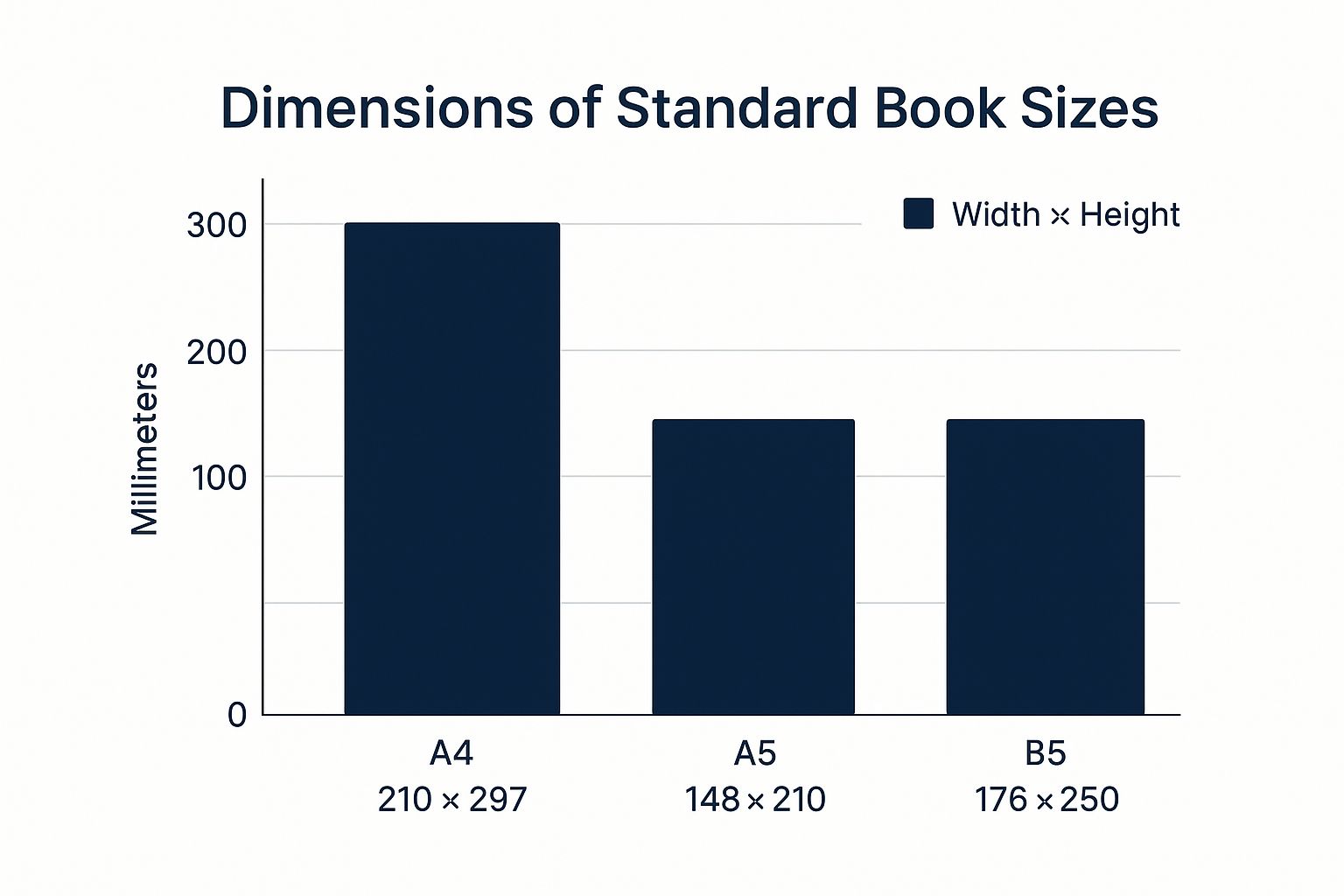
As you can see, the A4 format is much larger, making it a natural fit for things like workbooks, while the A5 size is closer to a typical trade paperback, offering a nice balance of readability and portability.
To make this even clearer, here’s a quick-reference guide to the most common trim sizes you’ll find in the US market, broken down by genre.
Common Standard Book Sizes by Genre
| Genre | Common Trim Size (Inches) | Typical Use Case |
|---|---|---|
| Fiction (Trade) | 5.5" x 8.5" or 6" x 9" | The standard for novels, thrillers, fantasy, and literary fiction. |
| Fiction (Mass-Market) | 4.25" x 6.87" | Pocket-sized editions sold in airports and grocery stores. |
| Novella | 5" x 8" | A slightly smaller, elegant size for shorter fiction works. |
| Memoir / Nonfiction | 6" x 9" | Balances readability with a professional feel for serious topics. |
| Children's Picture Book | 8.5" x 11" or 10" x 8" | Large format to showcase illustrations and facilitate shared reading. |
| Photography / Art Book | 8.5" x 11" or larger | Provides a large canvas to let high-quality images shine. |
| Cookbook | 7.5" x 9.25" | A practical size that fits on a kitchen counter but allows for great photos. |
By getting familiar with these genre conventions, you can make a smart decision that signals professionalism and gives your book the best possible chance to find its readers. Ultimately, your book's dimensions are a silent promise to the reader about the experience that awaits them inside.
How to Choose the Right Dimensions for Your Book
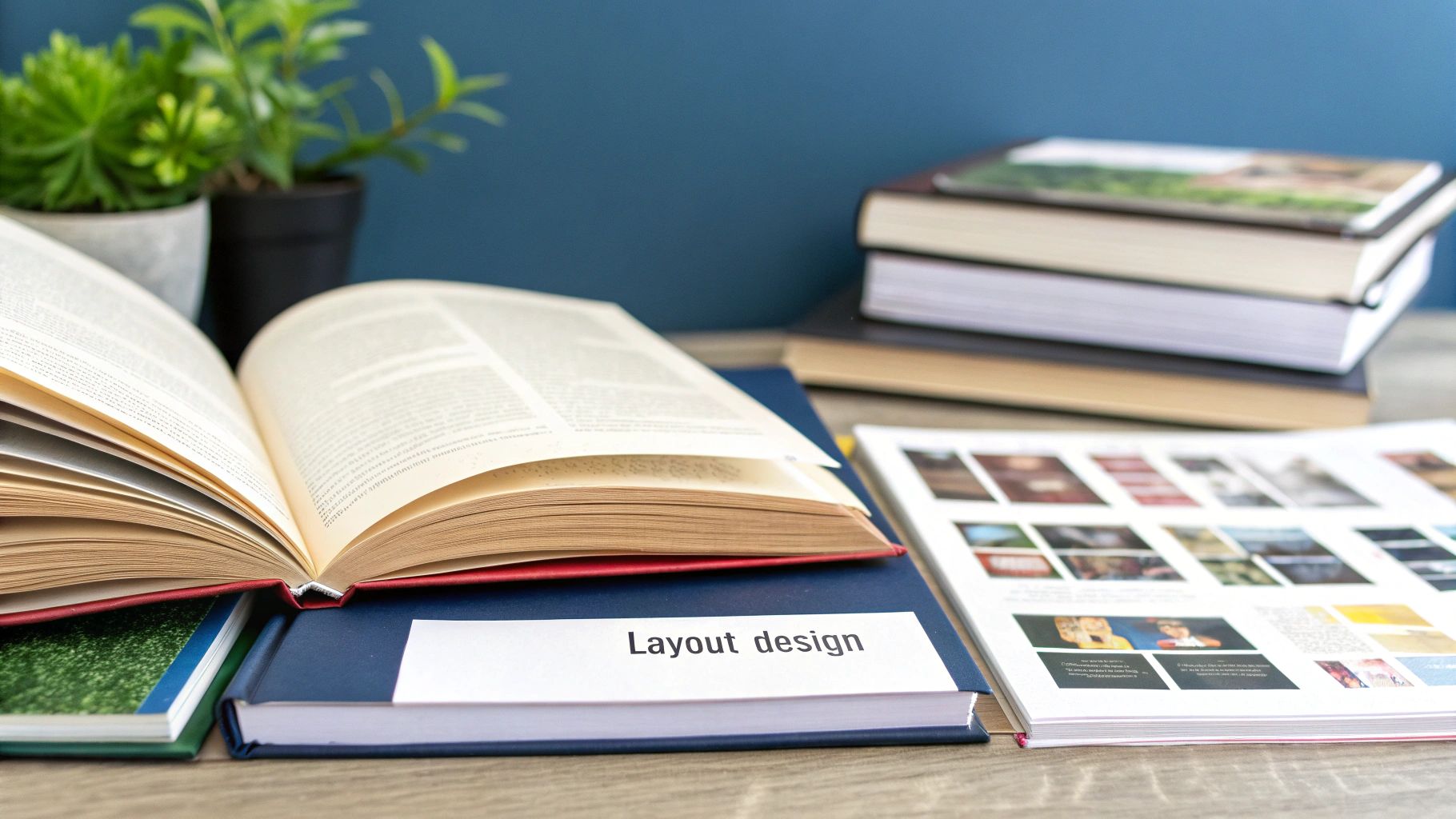
Knowing the industry-standard sizes is one thing, but actually picking the right one for your manuscript is where the real work begins. Choosing the right standard book size isn't about finding one perfect answer. It's a balancing act, a careful weighing of several factors to find the ideal fit for your specific project.
Think of it like choosing a frame for a painting. A delicate little watercolor would be swallowed by a massive, ornate frame. A giant oil painting would look absurd in a thin, flimsy one. The frame has to serve the art, and your book’s dimensions have to serve your content.
Let's walk through the four critical factors that will guide you to the perfect choice.
Evaluate Your Genre Conventions
The first and most important checkpoint is your book's genre. As we’ve covered, readers have deep-seated, often subconscious expectations for how a book in a certain category should look and feel. Straying too far from these norms is a gamble—you risk confusing potential buyers or even making it hard for bookstores to know where to shelve your work.
Start by asking yourself a couple of simple questions:
- What are the common sizes for bestsellers in my niche? Seriously, go to a bookstore. Pick up books that will sit next to yours on the shelf. Browse online retailers and pay close attention to the listed dimensions.
- Is my book a straight genre, or a hybrid? If it's a mix, you might have a little more wiggle room, but it’s still smart to lean toward the conventions of your primary genre.
Aligning with genre expectations is the surest way to signal to readers, "This book belongs here." It tells them your work is professional and fits right in with their other favorites.
Consider Your Manuscript's Word Count
The length of your manuscript has a massive impact on the final physical book. Your word count directly translates to page count, which in turn determines the book's thickness, its weight, and, crucially, its printing cost. This is where you have to balance the reader's experience with the practical reality of production.
A shorter book, like a 30,000-word novella, can feel a bit thin or flimsy in a large 6" x 9" format. But put that same story in a cozier 5" x 8" trim, and it suddenly feels more substantial and thoughtfully designed.
On the other hand, a sprawling 180,000-word epic fantasy would become a monstrous, phone-book-sized brick if you tried to cram it into a small mass-market format. Choosing a larger trade paperback size like 6" x 9" spreads out the page count, making the book far more comfortable to hold and read.
Your trim size is a tool to manage perception. A smaller size can make a short book feel dense and complete, while a larger size can make a long book feel more approachable and less intimidating.
Analyze Your Target Audience and Their Habits
Who are you writing for? More importantly, how, where, and when will they be reading your book? The physical format needs to fit seamlessly into your reader's lifestyle.
For instance, if you've written a business book for busy executives, a compact trade paperback they can easily toss in a briefcase is a no-brainer. If you've created a stunning photography book, your audience fully expects a large format that showcases your images in glorious detail.
Think through these practical scenarios:
- Children's Books: Large formats are perfect for shared reading time, with a parent and child looking at the pages together.
- Cookbooks: A size that can lie flat on a kitchen counter without snapping shut is a huge plus.
- Workbooks: The classic 8.5" x 11" format gives people plenty of room to actually write in the margins and do the exercises.
Weigh Your Budget and Publishing Goals
Finally, your decision has to make financial sense. The trim size you choose directly hits your per-unit printing cost. Bigger books and non-standard custom sizes simply require more paper and specialized handling, which drives up your expenses.
For most indie authors using print-on-demand services like IngramSpark or KDP Print, sticking to an industry-standard size is the most cost-effective route. These sizes are the bread and butter of printers, optimized for efficiency, which minimizes paper waste and keeps your costs down. Ultimately, this allows you to set a competitive price while still keeping a healthy profit margin.
Before you lock anything in, get printing quotes for the two or three standard sizes you’re considering. Seeing the actual cost difference in black and white can make the decision crystal clear, helping you find that sweet spot between reader experience, professional polish, and a healthy bottom line.
How Trim Size Shapes Your Book's Interior Design
Think of your book's trim size as the foundation of a house. It does more than just determine the final shape; it sets the stage for the entire interior design. If you get the foundation wrong, everything you build on top of it will feel a little off, no matter how well-crafted the individual rooms are.
Your book’s dimensions are the canvas you give your designer. This single choice dictates every other critical layout decision, from how wide the margins are to the size of the font. A bad choice here can create a frustrating reading experience before anyone even gets to chapter one.
For instance, picking a trim size that’s too narrow for your genre can result in a cramped, claustrophobic page. The lines of text become too short, and your reader’s eyes have to jump back and forth so rapidly it becomes exhausting. On the other hand, using a huge coffee-table-book format for a short novella can make the content feel sparse and lost in a sea of white space, which can cheapen the reader's perception of your work.
The Balancing Act of Margins and Readability
Margins are the unsung heroes of great book design. They aren't just empty space; they give the text room to breathe, frame the content beautifully, and provide a comfortable place for readers to rest their thumbs.
The width of your margins is a direct result of your trim size. A larger book format allows for more generous margins, creating an open, elegant feel. A smaller, mass-market trim size forces you to tighten those margins to fit a reasonable number of words on the page. It's a delicate balancing act. Go too narrow, and the text looks squished against the edges—a hallmark of an amateur job.
One of the most important margins is the gutter. That's the space in the very center of the book where the two pages meet in the binding.
- Perfect-bound paperbacks: The glue used in the spine will literally creep into the inner margin. If your gutter is too small, your words will disappear into that crevice, forcing readers to crack the spine just to finish a sentence.
- Spiral-bound workbooks: You need an even wider gutter to make room for the holes and the coil itself.
- Hardcover books: While the binding is different, a healthy gutter is still vital to prevent the text from curving out of sight near the spine.
Choosing the right trim size is the first step in creating a professional layout. It ensures you have enough real estate for proper margins, especially the gutter, so your text remains fully visible and easy to read.
Font Size and Line Length
Your trim size also dictates two other crucial elements: your font size and the line length (how many characters fit on a single line).
A wider page can comfortably accommodate longer lines of text, which means you can often get away with a slightly larger, more readable font. A narrow page, however, demands a smaller font and shorter lines to keep things looking clean and proportional.
The sweet spot for readability, according to decades of design wisdom, is a line length between 45 and 75 characters. If lines are much longer than that, it's easy for the reader's eye to get lost when jumping down to the next line. If they're too short, the rhythm of reading becomes choppy and stilted. Nailing this balance is all about matching the right trim size with the right font size.
For a much deeper dive into getting the interior just right, our guide on how to format a book covers all the professional touches. Getting these details right is what transforms a simple manuscript into a book that feels truly polished and respects the reader.
How Book Size Affects Your Wallet and Your Reach
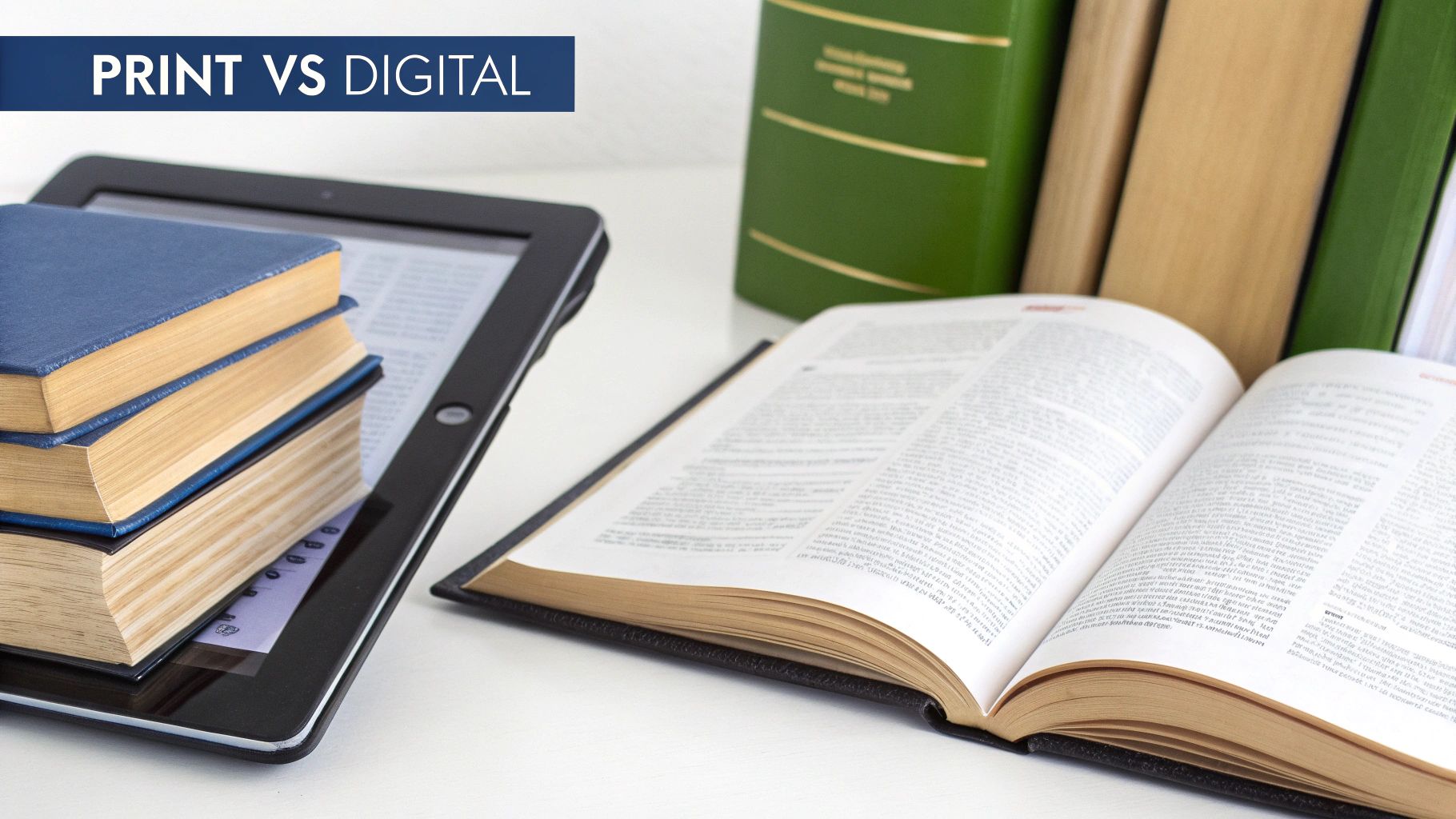
Alright, let's talk about the bottom line. This is where your choice of a standard book size really hits home—both in your bank account and in your book's ability to get out into the world. Every single choice, from the trim size down to the final page count, directly impacts how much it costs to produce your book and how easily it can land in a reader's hands.
Imagine a printer's massive roll of paper is like a bolt of fabric at a tailor shop. To be efficient and avoid waste, the tailor cuts patterns (your book's pages) in a way that uses as much of the material as possible. Standard book sizes like 5.5" x 8.5" or 6" x 9" are the industry's perfect patterns; they fit onto these master sheets with almost no paper left over. That efficiency is precisely why sticking to standards keeps your cost per book as low as possible.
The Financial Side of Trim Size
When you go rogue with a custom, non-standard dimension, you're essentially forcing the printer to create a brand-new, inefficient cutting pattern. That almost always means more wasted paper—scraps that you, unfortunately, still end up paying for. This holds true whether you're doing a huge offset print run or using a print-on-demand (POD) service for single copies.
Here’s how it breaks down:
- Standard Size (e.g., 6" x 9"): This is the sweet spot. It’s optimized for minimal waste, so the printer knows exactly how many pages they can get from a single sheet. The result is a predictable and lower cost for each book.
- Custom Size (e.g., 7.25" x 8.75"): This requires a special setup. It often creates awkward paper offcuts and might even mean using a different printing press, which drives up both the initial setup fees and your final cost per unit.
The difference might only be pennies per book, but it adds up fast. Over a print run of just 1,000 copies, choosing a standard size could easily save you hundreds, if not thousands, of dollars. If you want to see this in action, I highly recommend plugging some numbers into a book printing cost calculator. It gives you a real feel for how these variables play out.
Choosing a standard book size isn't a creative compromise; it's a strategic financial decision. It allows you to produce a professional-quality book at the most competitive price point, maximizing your potential profit margin.
The Unseen Hurdles in Distribution
The impact of your book's size goes far beyond the printer's invoice. Think about the entire journey your book takes to find its reader. Bookstores, warehouses, and libraries are all logistical systems built on standardization. Their shelves are a certain depth, and their shipping boxes are designed to pack common book sizes snugly.
An oddly shaped book throws a wrench in the works. It might not fit properly on a standard bookshelf, leaving a bookseller with no choice but to display it face-out or stick it in an awkward spot where no one sees it. That can be a death sentence for discoverability.
What’s more, major distributors have their entire operations fine-tuned for common formats. While they can and do handle custom sizes, it often creates friction in their system. Booksellers are simply more inclined to stock titles that slide effortlessly into their existing inventory and display setups. A non-standard book size can become an accidental roadblock, potentially limiting your access to the very sales channels you need for your book to succeed. By working with industry norms, you’re making your book as easy to sell as it is to print.
Common Questions About Book Sizes
Even after you've learned the basics, a few nagging questions always seem to pop up when it's time to actually pick a standard book size. It can feel like a big commitment, but let's walk through the most common things authors ask to help you move forward with confidence.
What Is the Most Common Book Size?
If you walk into any bookstore, you're almost certainly surrounded by two main sizes: 6" x 9" and 5.5" x 8.5". These are the true workhorses of the publishing industry, covering the vast majority of trade paperbacks in both fiction and nonfiction.
The 6" x 9" format is often seen as the gold standard. It just feels substantial and professional in your hands, which is why it's a favorite for novels, memoirs, and business books. The slightly smaller 5.5" x 8.5" is another incredibly popular choice for fiction, offering a more portable feel without sacrificing the reading experience.
Can I Use a Custom Size for My Book?
Technically, yes, you can. But before you jump down that rabbit hole, you need to understand the trade-offs.
Choosing a non-standard size means you're stepping outside the well-oiled machinery of printing and distribution. It can absolutely make your book stand out, but it almost always comes with higher printing costs and can make it a headache for bookstores to stock.
Ask yourself if the creative benefit is truly worth the very real financial and logistical hurdles. For most authors, especially if this is your first book, sticking to an industry-standard size is the smarter, safer, and more budget-friendly path.
Does Trim Size Affect My Book's Spine Width?
It absolutely does, though indirectly. The final width of your spine comes down to two things: your total page count and the thickness of the paper your printer uses (often called PPI, or pages per inch).
Here's where trim size comes into play. A 100,000-word manuscript laid out in a compact 5" x 8" book is going to have a lot more pages—and a much thicker spine—than that same manuscript formatted for a roomier 6" x 9" page. This is a critical piece of information for your cover designer; they need that exact spine measurement to make sure your cover art wraps around perfectly.
Ready to bring your book to life without the guesswork? The expert team at BarkerBooks guides you through every step, from selecting the perfect trim size to global distribution. Discover how we can help you publish professionally.
